FAMOUS MAKER J.W. NORIE EARLY ENGLISH OCTANT
Ca 1795
NORIE FOWLED ANCHOR LOGO on ARC
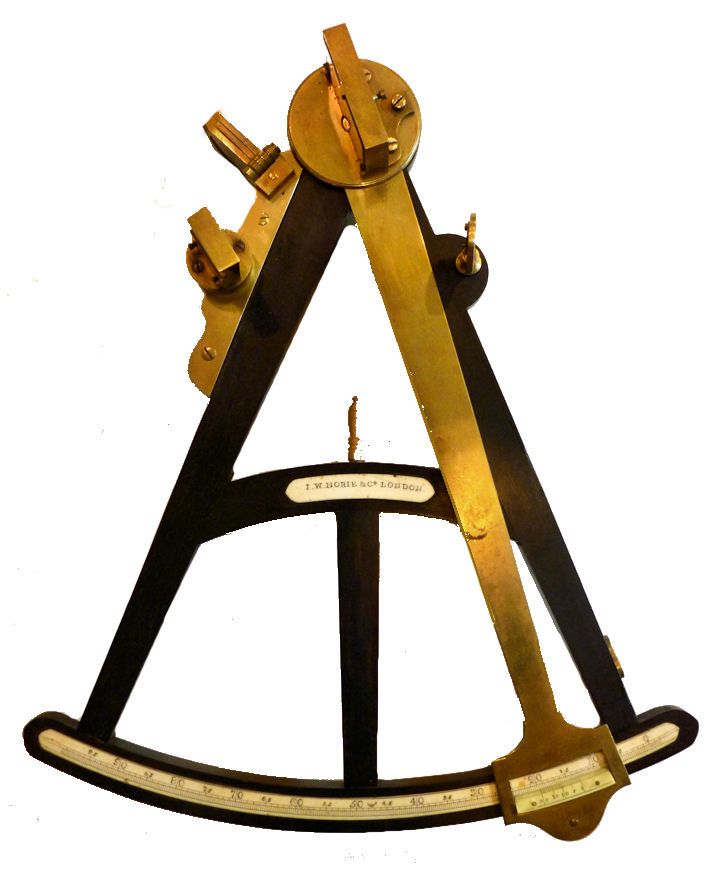
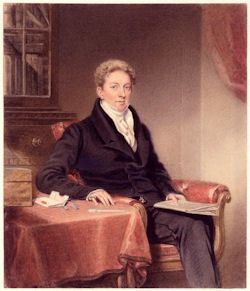 PRESENTED is as rare an octant as you will
PRESENTED is as rare an octant as you willfind and one which will appeal to those familiar with the history of navigation. It was made by John William Norie (1772-1843), a
mathematician, hydrographer, chart maker, and publisher of nautical books, most famous for his Epitome of Practical Navigation (1805), which became a standard work on navigation and went through many editions, as did many
of Norie’s works. His known navigation instruments are few, and normally
found in museums such as the British National Maritime Museum in Greenwich, and the USS Constitution Museum in Boston.
chart publishers Mount and Page, and who ran the Naval Academy and Naval Warehouse in Leadenhall Street from 1795; the Naval Warehouse provided navigational instruments, charts, and books on navigation. Norie took over the Naval Warehouse after Heather’s retirement and founded the company J.W. Norie and Company in 1813. After Norie’s death, the company
became Norie and Wilson, then in 1903, Imray, Laurie, Norie & Wilson. They continue in business as chart makers and were based in
London until 1939, and are now headquartered in St Ives in Cambridgeshire.
Even though Norie did not adopt the name of J.W. Norie & Co. until 1813, the design of this instrument
is earlier. For example, it does not have a tangent screw and there is no brace on the index arm, and it uses a peep sight rather
than a telescope. It is fitted with only one set of shade glasses (filters). Imprinted on the arc between 45°; and 50° is a partial
anchor which is the authoritative work,
by W.F.J. Morzer-Bruyns, shows Norie, among
others, using this symbol.
The quality of the machining and beautifully crafted ebony frame indicate this instrument was made by an
advanced instrument maker, one who would stand at the top of his trade. The large size of the degrees and the variation
in their width indicate they were hand engraved rather than cut by a machine. It has been polished and lacquered at an earlier time and is
ready to be presented as a gift.
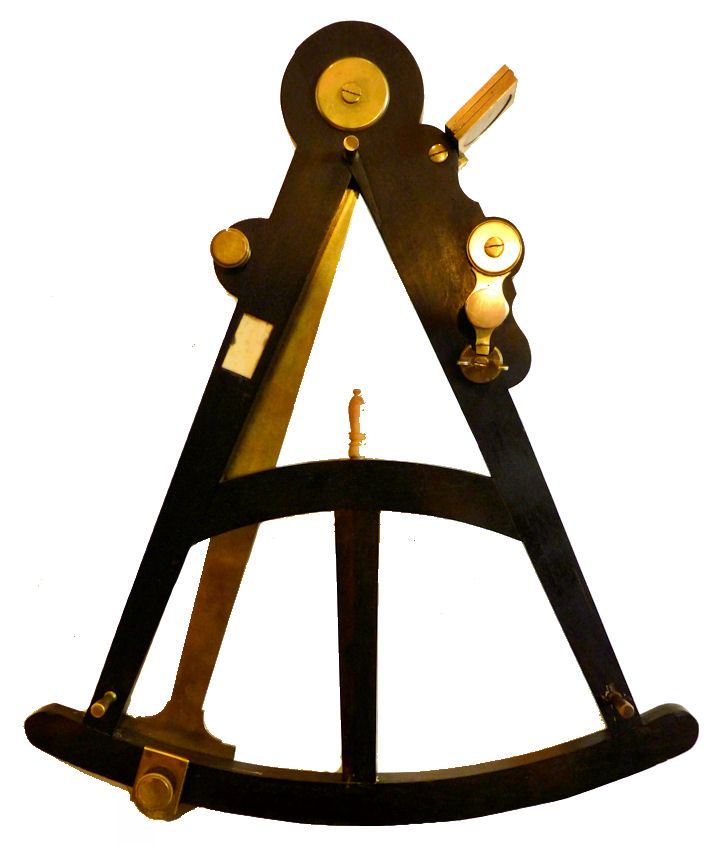
The back shows the interrelated machined parts of the instrument
CONDITION: The instrument is in excellent condition. The graduated arc and all its hardware are present. All three
bronze legs are original. It has the often lost ivory pencil on the crossbar which is glued in place. The index mirror
and horizon mirror only show a little age. The three shades are intact. The knurled screw on the back
is a replacement and accounts for the octant not resting evenly on its
legs. There is a tiny split just above the cross bar on the aft side of the frame.
THE CASE is of keystone design. The top has an age crack and there is a small piece missing from the bottom right corner,
but everything is secure. There is a saw cut on the left front which is unusual. There are no labels or notations inside. There is a
hook and eye but no lock.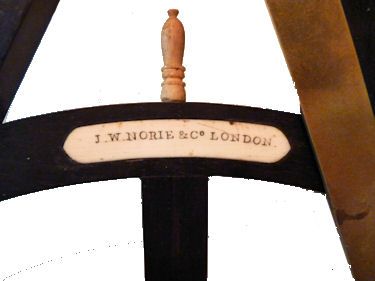 Maker’s name on the cross bar
Maker’s name on the cross bar
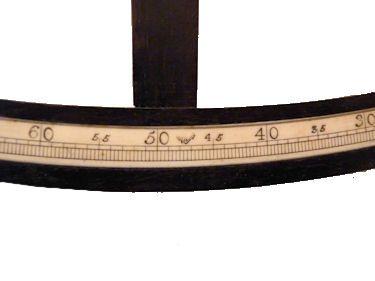
Fowled Anchor
This octant is marked J. W. Norie & Co.London on the crossbar with the name listed in Webster’s Database of
Instrument Makers. This database has numerous references for all the names and companies associated with Norie.
The instrument is 13 7/8 inches on the vertical which is still oversized for octants, but smaller
than the typical Hadley-style octant of 17.
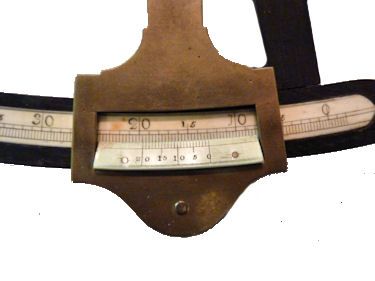
Vernier reads from the right in one-minute increments
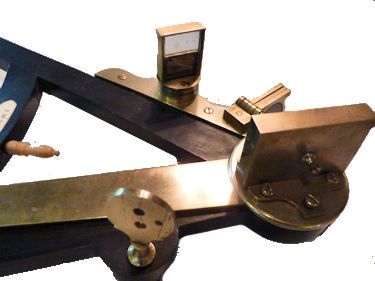
Peep sight and good condition horizon mirror
MARKINGS:
You can clearly see the flukes of a fowled anchor between 45 and 50 degrees position on the arc. This
mark is attributed to several makers including John Norie,
Jessie Ramsden and others. The arc is hand-scribed in large numbers each ten degrees, and in numbers half as large
for the 5th degree. The vernier reads from the right from 0 to 20 minutes in one-minute increments.
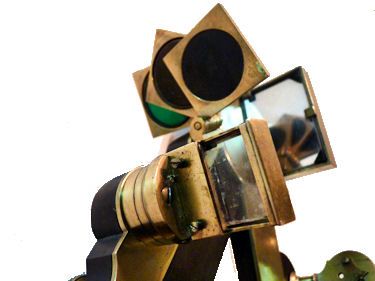 Two red and one green shade
Two red and one green shade
glasses
 The Index Mirror is in excellent condition
The Index Mirror is in excellent condition
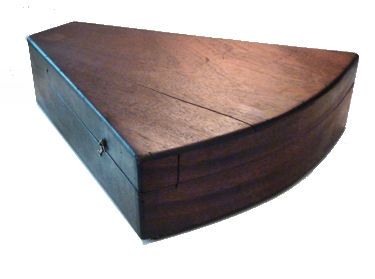
Closed case note saw
mark
DATING THE INSTRUMENT:
The ivory arc measures from – 5 to plus 95 degrees on an Ebony frame which is in excellent condition. It is known that Mahogany went out
of use in favor of Ebony sometime after 1750. The octant has a flat brass index arm,
without a stiffening brace, that measures 13 7/8 inches to the bottom of the index arm. Tangent screws began replacing finger
clamps in the last quarter of the 18th Century. The horizon mirror
is mounted on an adjustable turntable where the base can be rotated by loosening a screw which locks the mirror’s position.
There is a single set of fixed shades, three in number. The ivory vernier scale, reads from right to left from 20 to 0 arc
minutes. There is a single peep sight. The adjustable tangent screw followed the use of
the index arm clamp which ended around the last quarter of the 1700’s. This instrument has a clamp. The gradations are cut by
hand rather than by machine. features date the instrument after 1750 and before 1800.
See Peter Ifland’s
comprehensive sextant work, “Taking the Stars”. particularly figure 64, page 57. Open
Open
fan style case.
No markings or labels
A very rare and pedigreed example of an early octant of a famous Maker
